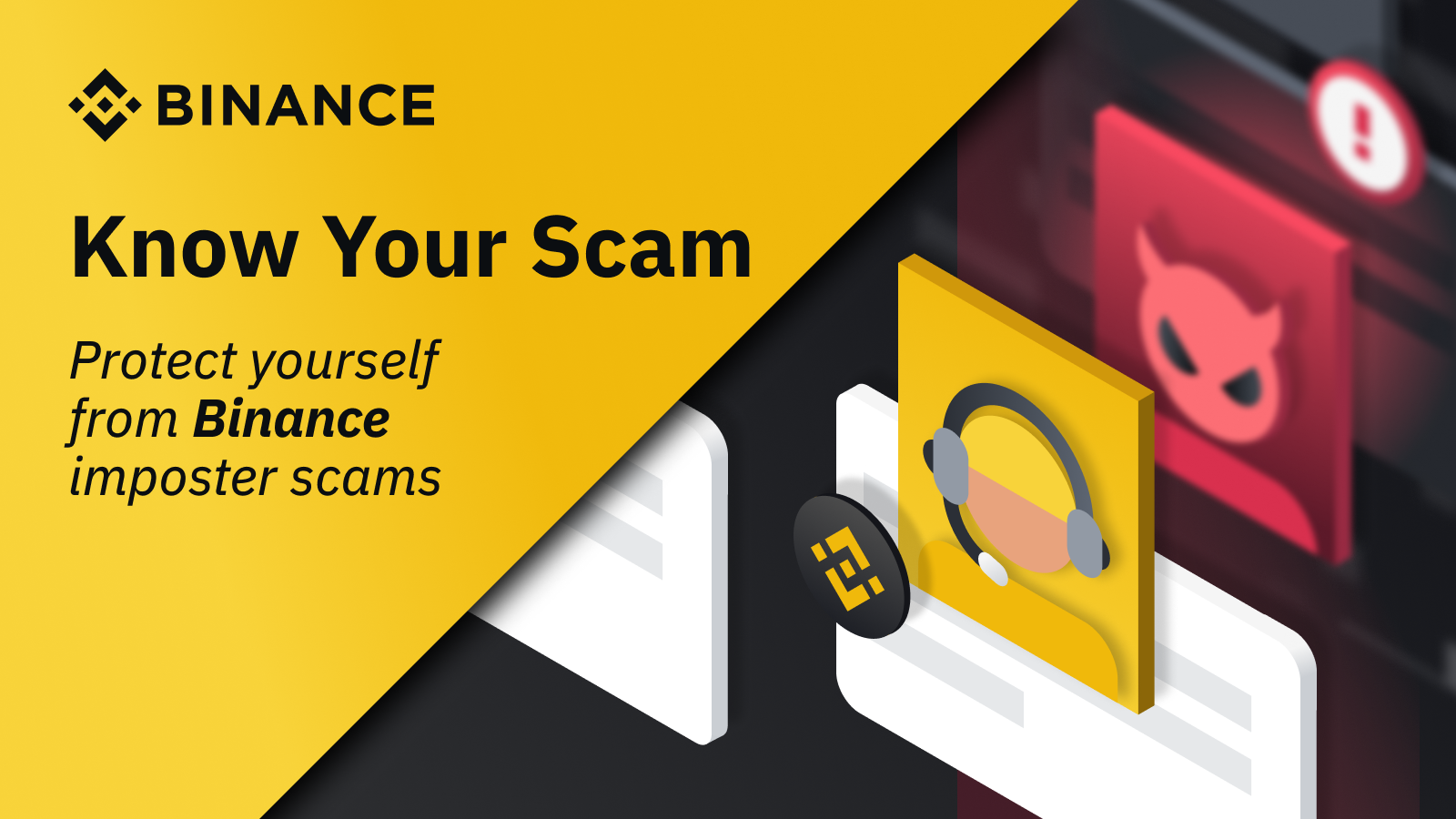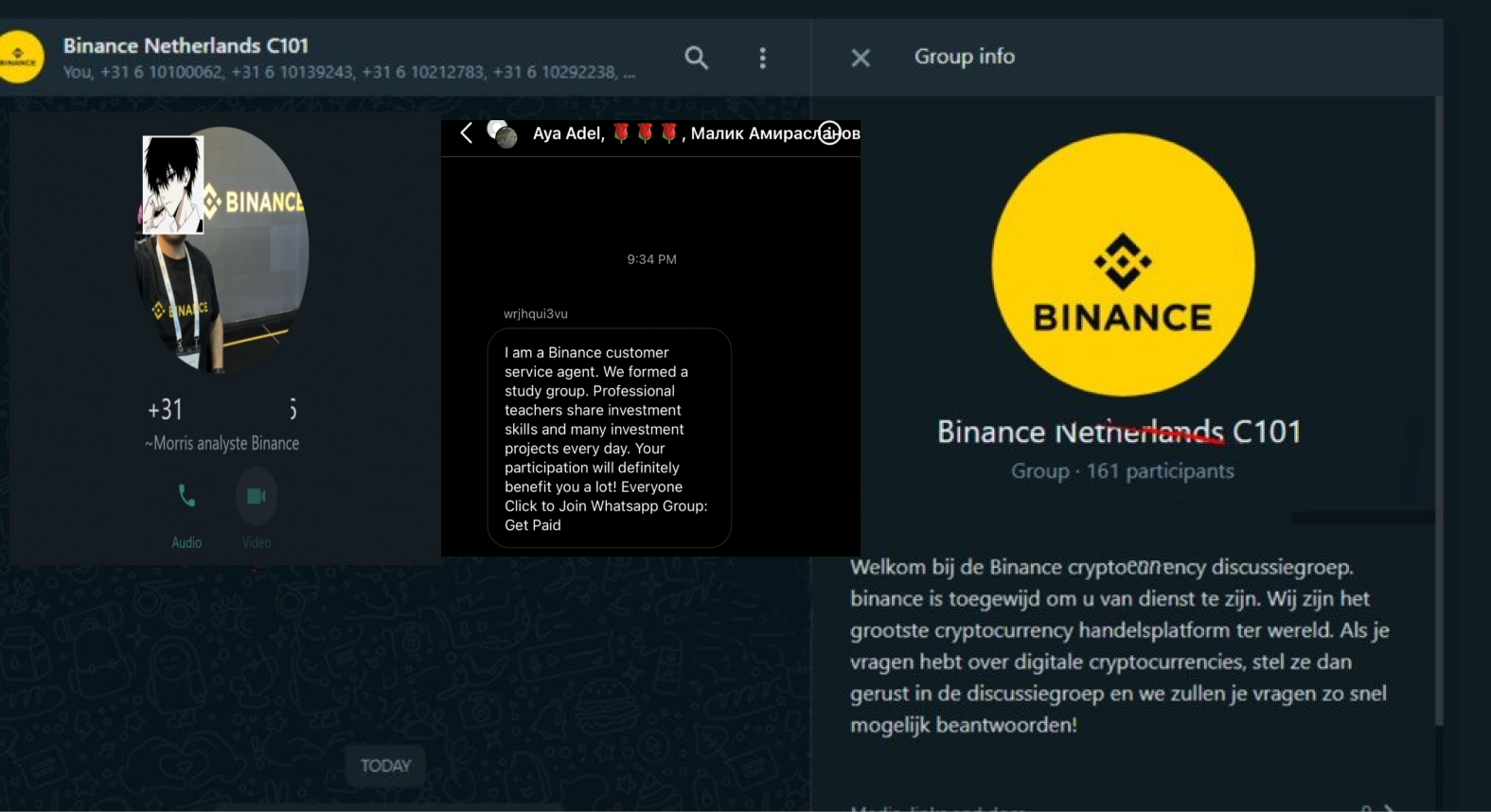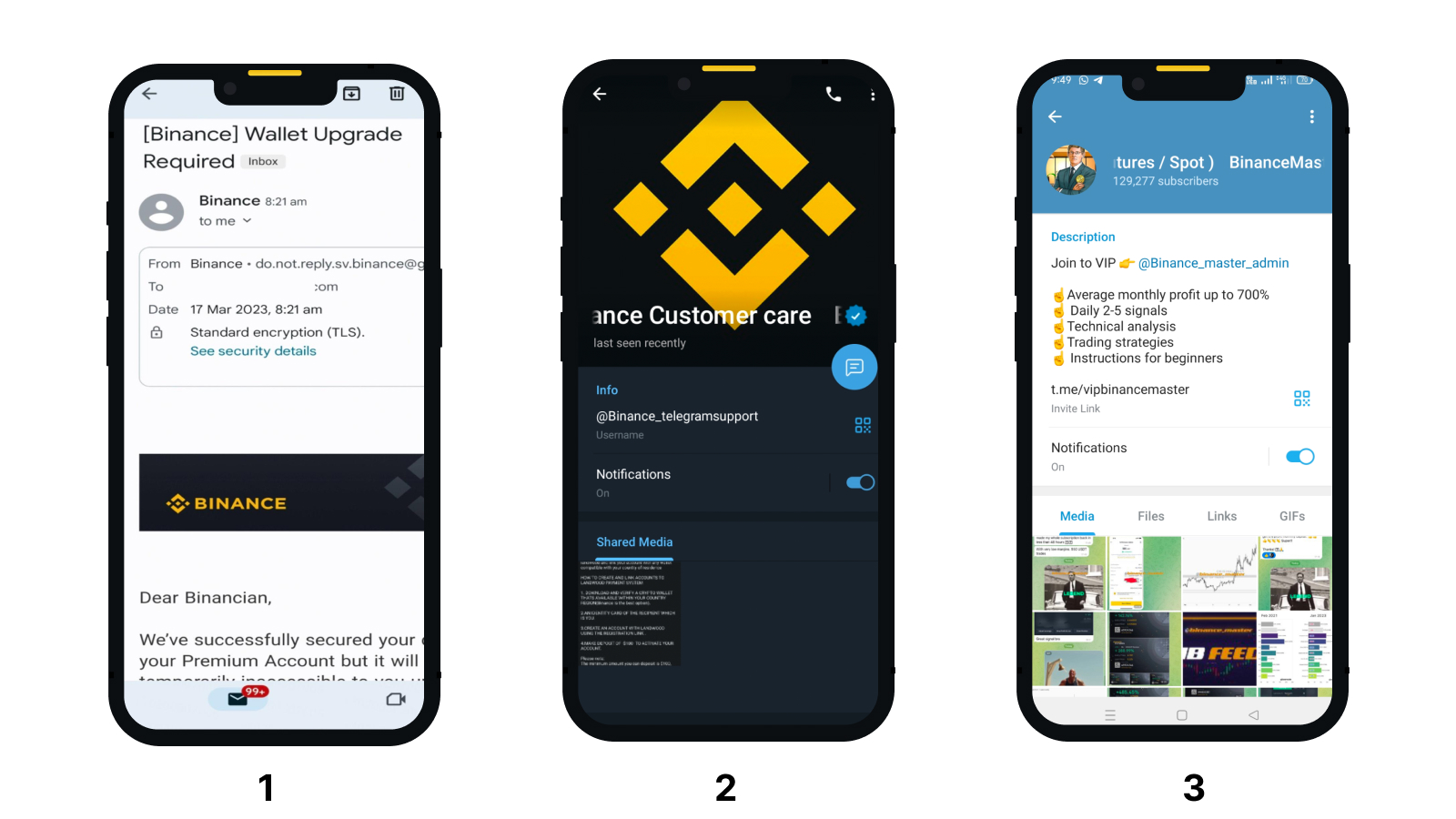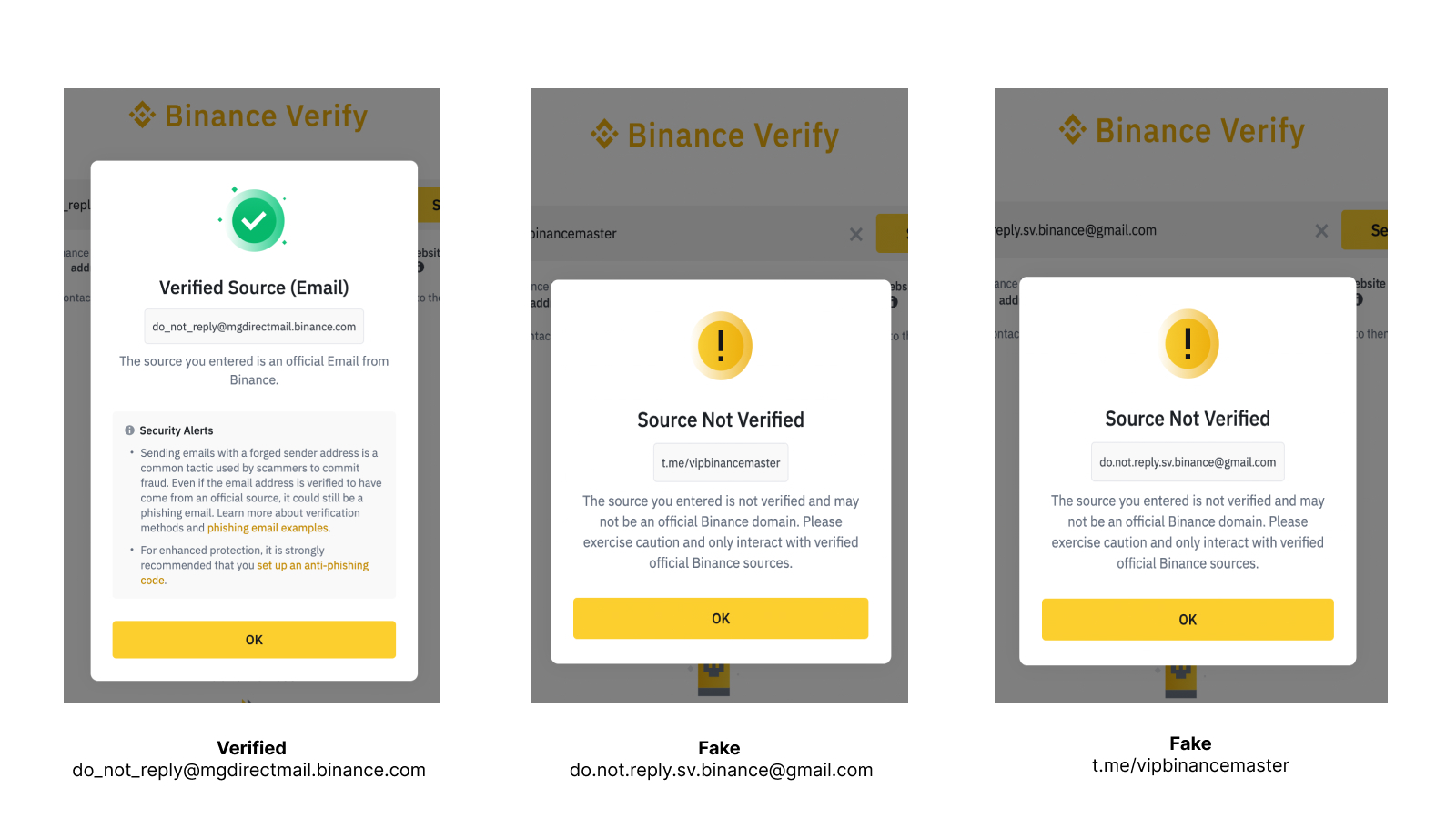Main Takeaways
Binance imposter scams involve criminals posing as Binance employees or representatives to offer fake services designed to steal people’s money.
Scammers reach out to potential victims via unofficial email or social media accounts that look similar to official Binance accounts.
If you’ve fallen victim to a Binance imposter scam, report the incident immediately to relevant local authorities and the Binance Support team.
Safeguard your account from Binance impersonators. Learn how scammers build trust, along with tips to identify and report fake Binance profiles in this week's edition of Know Your Scam.
Today, anyone with internet access can create a fake social media profile using the Binance name and logo.
You may have stumbled upon fake Binance profiles on a Twitter thread, in the comments section of an Instagram post, or directly reaching out to you through a messaging app like Telegram.
The reality is that we have no control over the moderation of these platforms. Binance imposters can set up a new account in seconds, even after we’ve flagged them to the relevant platform’s moderation team.
If there’s one thing you should know about our employees: We will never — under any circumstances — proactively contact users via unofficial channels to offer investment advice, entry into a free giveaway, or a “backdoor” to unlock your Binance account.
To help you protect your Binance account, we’ve outlined the four-step process Binance imposter scammers typically use and broken down several screenshots of Binance imposters we’ve encountered.
A Four-Step Process of How Binance Imposters Scam Victims
1. Building a fake identity
The first step: crafting the perfect lie. Imposter scams, which we covered in last week’s article, typically involve a fraudster posing as an authority figure like a police officer.
In this instance, however, the scammer fashions a false identity along with an elaborate script around being a Binance employee. They’ll create a fake account, complete with the Binance logo or a photo of an individual wearing a Binance T-shirt as their profile picture.
Their usernames often include titles like Binance Customer Service, Binance staff-xxx, or Binance Promo, while their email addresses are remarkably similar to the official ones.
2. Targeting victims on social groups
Scammers will scour the black market to get their hands on sensitive personal data, including phone numbers, emails, identity credentials, and even records of past purchases and travels. These ill-gotten details are then meticulously sifted through to identify potential victims who are likely to be manipulated.
Some scammers prefer to attract new victims by setting up an “official Binance” group — purportedly led by real Binance employees — that offers investment advice and lucrative opportunities to earn money.
3. Gain trust and induce
The scammer now begins building trust through a script meticulously tailored to their newly-acquired target. The objective is to establish a rapport with the victim, creating a false sense of familiarity and, ultimately, coaxing them into falling for the scam.
Advanced scammers exhibit an impressive ability to adapt to the situation, persist in their efforts, and improvise their responses on the fly, even when the targeted victim appears unresponsive or uncooperative at first.
4. Close
The victim has fallen for the scammer’s false identity. They’ll follow the scammer’s request to send funds or, even worse, provide their Binance login credentials. With access to the victim’s Binance account, the scammer could potentially empty the account’s entire crypto balance into their wallet before the victim regains access.
To illustrate how this four-step process works in practice, we’ve provided some real-life cases below.
Examples in Action
Example 1: Insider trading information — WhatsApp Binance group
The user, who we’ll call Mark, is fresh to the crypto world. He is contacted by a “Binance analyst” named Morris.
Through an Instagram message, Morris informs Mark about a WhatsApp group that shares crypto investment advice and insider trading information, with guaranteed returns of up to 20%. Morris invites Mark into the group, inside of which there are several “Binance employees” who regularly post guides on how to make money, along with group members who share their massive winnings.
Mark also notices the “Binance employees” answer every question in a professional manner. Believing this is a legitimate group, Mark follows the tutorials, which instruct him to withdraw tokens to the scammer’s wallet address.
Of course, none of this is genuine, and Mark finds himself the victim of an imposter scam.
“Welcome to the Binance cryptocurrency discussion group. Binance is dedicated to being of your service. We are the biggest crypto trading platform in the world. If you have questions about crypto, please ask them in the group, and we will answer them as soon as possible.” - English translation of the scammer’s WhatsApp group description.
Example 2: “Binance trading expert”
Social media platforms like Instagram are rife with fake profiles who claim they’re affiliated with or employed by Binance. For example, in this recent case, the scammer has intentionally placed an @binance handle in their bio. Note that their bio also includes a wide range of buzzwords like “Trader Expert” and “Investment Specialist.”
Unfortunately, malicious actors often try leveraging our influence and reputation in the crypto sector — one that millions of users trust globally — to prey on unsuspecting victims. Binance employees are strictly prohibited from trading or offering investment advice. Do not trust any “Binance employee” claiming to be a trading or investment guru. Regarding affiliates and KOLs, while we strictly vet all of them to ensure their content is sound, their views and opinions do not reflect ours.
An easy way to identify a fake Instagram profile is to check its follower count compared to the number of likes or comments it receives. If there is a significant mismatch, for example, 25,000 followers but only 100 likes and two comments per post — this is likely a fake profile.
Other examples
Wallet upgrade. The user receives a fake Binance email from ‘do.not.reply.sv.binance@gmail.com’ requesting they “upgrade their application.” You’ll notice the email address says gmail.com instead of our official domain: binance.com.
Binance Customer Care. This scammer is attempting to scam a user by posing as a Binance Support employee under the alias “Binance Customer Care.”
Binance VIP. This scammer is providing fake crypto investment advice under the guise of a Binance employee who helps run Binance VIP, our benefits program for institutional and high-volume professional traders.
Tips to Protect Yourself From Binance Imposter Scams
Beware of self-proclaimed Binance staff
Don’t instantly trust a supposed “Binance employee” who reaches out to you via phone or social media such as Telegram, WhatsApp, Instagram, etc. Our employees will never proactively message users via unofficial channels to provide investment advice, entry into a giveaway, or account-unlocking services.
Pay attention to the username or the email address, particularly the domain name at the end. You can verify the authenticity of email addresses and website links on Binance Verify. Users should still exercise caution if the link appears as “Verified” and avoid links appearing as “Source Not Verified.”
Protect your private information
To safeguard yourself from potential fraud, it’s crucial to keep your personal information secure, including travel and shopping history and contact details.
As mentioned earlier in the article, scammers will often use the dark web to acquire carelessly-managed personal data to find their next target.
If You’ve Been Scammed
In the unfortunate event that you have been scammed, be wary of further attempts by the same fraudsters and refrain from processing any withdrawals or transfers initiated by strangers.
Seeking assistance from local government authorities is advised if you have fallen victim to a Binance imposter scam. If your Binance account is compromised, immediately file a report by following the steps outlined in this guide: How to Report Scams on Binance Support.
We also encourage all users, both new and old, to read through our anti-scam series to better equip themselves against common crypto scams.
Further Reading
(Blog) Know Your Scam: A Definitive Guide to Crypto's Most Prevalent Scams
(Blog) Know Your Scam: Fake Crypto Investments to Watch Out For
Disclaimer and Risk Warning: This content is presented to you on an “as is” basis for general information and educational purposes only, without representation or warranty of any kind. It should not be construed as financial advice, nor is it intended to recommend the purchase of any specific product or service. Digital asset prices can be volatile. The value of your investment may go down or up and you may not get back the amount invested. You are solely responsible for your investment decisions and Binance is not liable for any losses you may incur. Not financial advice. For more information, see our Terms of Use and Risk Warning.







